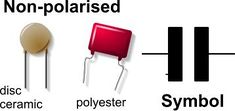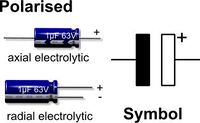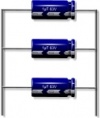Capacitor: Difference between revisions
From DT Online
m (Added Template) |
(Added Template) |
||
| (5 intermediate revisions by the same user not shown) | |||
| Line 1: | Line 1: | ||
[http://en.wikipedia.org/wiki/Capacitor '''Capacitors'''] are used to store electric charge which can be released into a circuit when required. The unit of capacitance is the '''farad''' which is a very large unit, named after [http://en.wikipedia.org/wiki/Michael_Faraday '''Michael Faraday''']. | [http://en.wikipedia.org/wiki/Capacitor '''Capacitors'''] are used to store electric charge which can be released into a circuit when required. The unit of capacitance is the '''farad''' which is a very large unit, named after [http://en.wikipedia.org/wiki/Michael_Faraday '''Michael Faraday''']. | ||
Most commonly used capacitors are rated in '''microfarads''' - '''µF''' ''(millionths). | |||
Large value capacitors are often used as smoothing capacitors in [http://en.wikipedia.org/wiki/Alternating_current '''A.C.'''] power supplies. Other uses for capacitors are in timing circuits and filter circuits. | Large value capacitors are often used as smoothing capacitors in [http://en.wikipedia.org/wiki/Alternating_current '''A.C.'''] power supplies. Other uses for capacitors are in timing circuits and filter circuits. | ||
__TOC__ | |||
=====Capacitor Types===== | |||
There are two main types of capacitor - '''''polarised''''' ''(or polarized)'' and '''''non-polarised'''''. | |||
{| | |||
|- | |||
| '''Non-Polarised''' capacitors can be connected in a circuit either way round but they are normally only available in values up to 1µF. They can be constructed in a number of different materials and appear in different forms. Some of the more common ones are illustrated here. | |||
| [[File:Non-PolarisedCapacitor.jpg|235px|right]] | |||
|- | |||
| '''Polarised''' capacitors must be connected with their "+" connection to the higher potential for them to function correctly. Elecrolytic capacitors are the most common polarised capacitors in use. The values of electrolytic capacitors starts at about 1µF and can extend to many thousands. | |||
| [[File:PolarisedCapacitor.jpg|200px|right]] | |||
|} | |||
Regard must be paid to the working voltage of a capacitor. This information is usually stamped on the device. A capacitor must not be subjected to a higher voltage than its working voltage. | |||
Most capacitors have their value written upon their body but some polyester types use a colour code similar to the resistor colour code. Larger value electrolytic capacitors tend to suffer from relatively high leakage current. This means the charge on the capacitor gradually disappears through leakage, so using them in timing circuits can make the timing period inaccurate. | |||
=====Capacitors in Circuits===== | |||
Capacitors can be joined together in '''parallel'''. | Capacitors can be joined together in '''parallel'''. | ||
[[File:CapacitorsParallel.jpg|100px|right]] | [[File:CapacitorsParallel.jpg|100px|right]] | ||
| Line 31: | Line 45: | ||
:C ''(Total)'' = _____C1xC2xC3____ | :C ''(Total)'' = _____C1xC2xC3____ | ||
::::C1xC2+C2xC3+C3xC1 | ::::C1xC2+C2xC3+C3xC1 | ||
=====Time Constant===== | |||
[[File:CapacitorResistor.jpg|200px|right]] | [[File:CapacitorResistor.jpg|200px|right]] | ||
Capacitors may also be connected together end to end in series with a '''[[resistor]]''' to create a '''resistor–capacitor circuit''' [http://en.wikipedia.org/wiki/RC_circuit '''(RC circuit)'''] in which a capacitor charges or discharges through a resistor for a known period of time known as the [http://en.wikipedia.org/wiki/Time_constant '''time constant'''] | Capacitors may also be connected together end to end in series with a '''[[resistor]]''' to create a '''resistor–capacitor circuit''' [http://en.wikipedia.org/wiki/RC_circuit '''(RC circuit)'''] in which a capacitor charges or discharges through a resistor for a known period of time known as the [http://en.wikipedia.org/wiki/Time_constant '''time constant'''] | ||
| Line 37: | Line 54: | ||
:T''(seconds)''= C''(farads)'' x R''(ohms)'' | :T''(seconds)''= C''(farads)'' x R''(ohms)'' | ||
{{Resistors/Capacitors/Diodes Buyers Guide}} | |||
[[Category:Secondary]] | |||
[[Category:Electronics Components]] | |||
Latest revision as of 13:03, 3 July 2016
Capacitors are used to store electric charge which can be released into a circuit when required. The unit of capacitance is the farad which is a very large unit, named after Michael Faraday.
Most commonly used capacitors are rated in microfarads - µF (millionths).
Large value capacitors are often used as smoothing capacitors in A.C. power supplies. Other uses for capacitors are in timing circuits and filter circuits.
Capacitor Types
There are two main types of capacitor - polarised (or polarized) and non-polarised.
| Non-Polarised capacitors can be connected in a circuit either way round but they are normally only available in values up to 1µF. They can be constructed in a number of different materials and appear in different forms. Some of the more common ones are illustrated here. | |
| Polarised capacitors must be connected with their "+" connection to the higher potential for them to function correctly. Elecrolytic capacitors are the most common polarised capacitors in use. The values of electrolytic capacitors starts at about 1µF and can extend to many thousands. |
Regard must be paid to the working voltage of a capacitor. This information is usually stamped on the device. A capacitor must not be subjected to a higher voltage than its working voltage.
Most capacitors have their value written upon their body but some polyester types use a colour code similar to the resistor colour code. Larger value electrolytic capacitors tend to suffer from relatively high leakage current. This means the charge on the capacitor gradually disappears through leakage, so using them in timing circuits can make the timing period inaccurate.
Capacitors in Circuits
Capacitors can be joined together in parallel.
In this arrangement the total capacitance is equal to the value of all the capacitors added together - i.e. : C(Total)= C1 + C2 + C3...etc
Capacitors may also be connected together end to end in series.
In this arrangement the total capacitance is calculated as follows:
- ___1___ = _______1______
- C (Total) C1 + C2 + C3...etc
or
- C (Total) = _____C1xC2xC3____
- C1xC2+C2xC3+C3xC1
Time Constant
Capacitors may also be connected together end to end in series with a resistor to create a resistor–capacitor circuit (RC circuit) in which a capacitor charges or discharges through a resistor for a known period of time known as the time constant
In this arrangement the time constant is calculated as follows:
- T(seconds)= C(farads) x R(ohms)











